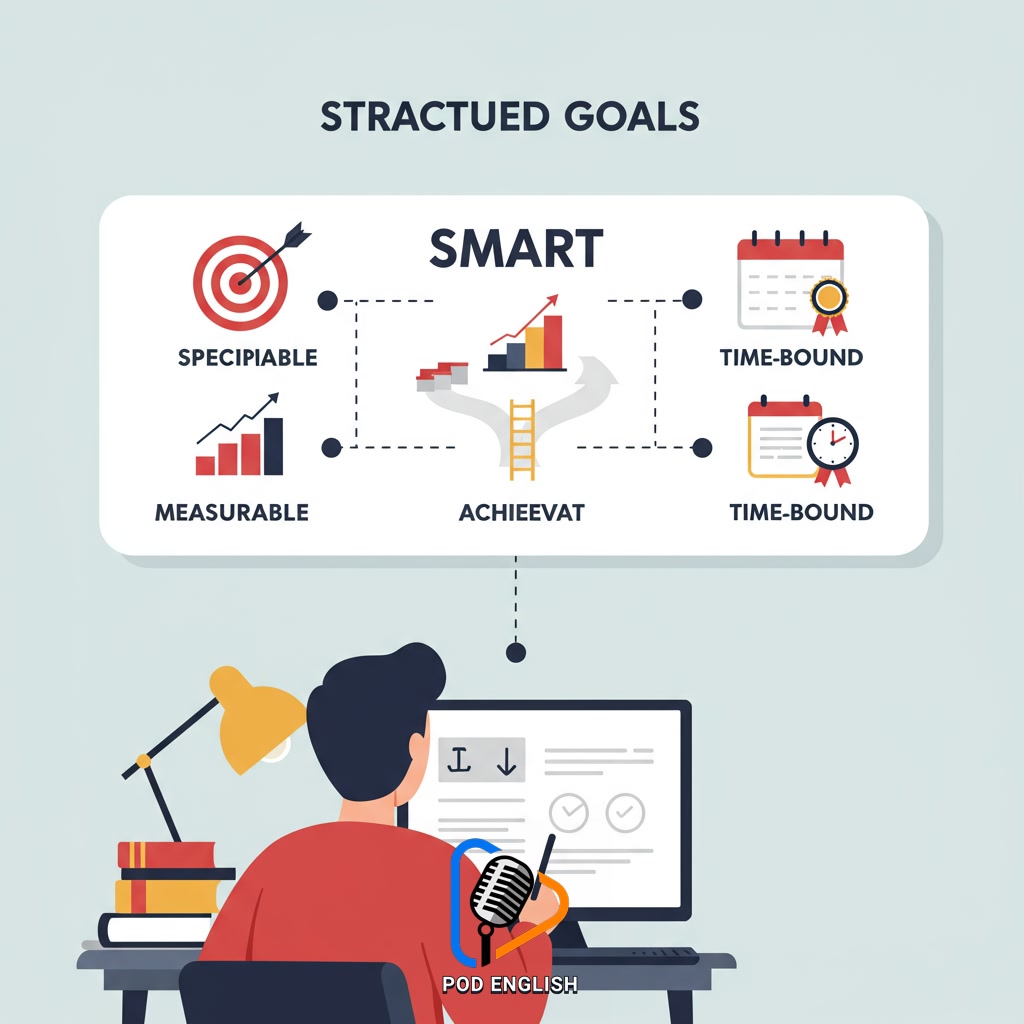Learn English
Master English Learning – Set Realistic Goals

Start English learning effectively by establishing achievable objectives. Setting realistic goals is key to maintaining motivation and tracking progress. Break down larger aspirations into smaller, manageable steps. This approach helps build momentum and ensures sustainable improvement in English proficiency.
Table of Contents
- Section 1: Why Realistic Goals Matter for English Learning
- Section 2: Assessing Your Current English Proficiency
- Section 3: Defining Your Learning Objectives and Needs
- Section 4: Applying SMART Principles to Set English Goals
- Section 5: Breaking Down Goals into Actionable Steps
- Section 6: Tracking Progress and Staying Motivated
- Section 7: Reviewing and Adjusting Your Learning Goals
Section 1: Why Realistic Goals Matter for English Learning
Setting realistic goals is absolutely crucial when you’re learning English. Many learners start with very ambitious, but perhaps too vague, aims like ‘become fluent in three months.’ When they inevitably don’t reach this unrealistic target, it’s easy to feel discouraged, frustrated, and even give up. Realistic goals, on the other hand, are specific, measurable, achievable, relevant, and time-bound (SMART). They break down the massive task of learning a language into smaller, manageable steps. This approach allows you to see your progress clearly, celebrate small victories along the way, and maintain momentum. Focusing on achievable milestones, like mastering a specific grammar point this week or having a short conversation by the end of the month, builds confidence and keeps you motivated for the long journey ahead. It transforms learning from an overwhelming mountain into a series of climbable hills.

Section 2: Assessing Your Current English Proficiency
Following the discussion on overly ambitious goals, the absolutely crucial next step is honestly assessing your current English proficiency. Think of it as finding your exact starting point on a map before planning your route to a destination. Without knowing where you are now, any goal you set might be completely unrealistic. This assessment isn’t about judgment; it’s about gaining a clear picture of your skills across reading, writing, listening, and speaking. You can use online tests, review past work, try practice exercises, or even seek feedback from a teacher. Identifying your current level – whether beginner, intermediate, or advanced – and understanding your specific strengths and weaknesses provides the essential foundation for setting goals that are challenging yet genuinely achievable and sustainable.

Section 3: Defining Your Learning Objectives and Needs
Following the assessment of your current English level, the critical next step is to clearly define *what* you want to achieve and *why*. Consider your specific purpose for learning English: is it for career advancement, academic study, travel, or simply personal enrichment? Identifying these practical needs allows you to pinpoint the precise skills you need to develop, whether it’s improving conversational fluency, mastering writing for professional contexts, or building vocabulary for specific subjects. Defining these concrete objectives transforms your learning from a general effort into a targeted mission, enabling you to select the most relevant resources and strategies for efficient and effective progress.

Section 4: Applying SMART Principles to Set English Goals
To transform your broad aspirations into actionable steps, applying the SMART framework is highly effective. SMART stands for Specific, Measurable, Achievable, Relevant, and Time-bound. A Specific goal clearly defines what you want to achieve (e.g., ‘improve my speaking fluency for business meetings’). It must be Measurable so you can track progress (e.g., ‘participate in 3 business calls per week’). Ensure the goal is Achievable given your current level and resources. It should be Relevant to your overall learning purpose. Finally, make it Time-bound by setting a clear deadline (e.g., ‘within the next three months’). Structuring your English learning goals using these principles provides clarity, helps maintain focus, and makes tracking your improvement concrete and motivating.

Section 5: Breaking Down Goals into Actionable Steps
Once you have defined your main English learning objective using the SMART framework, the crucial next phase involves dividing this larger goal into smaller, more manageable steps. Think of your ultimate aim as a destination; these smaller steps are the individual stages of your journey. For example, if your goal is to pass an English proficiency test in six months, breakdown might include: mastering specific grammar points each month, learning a set number of vocabulary words weekly, practicing listening comprehension daily, and completing practice tests bi-weekly. Each step should be concrete and have its own mini-deadline or completion criteria. This approach prevents you from feeling overwhelmed by the size of the main goal and allows you to celebrate smaller achievements along the way, maintaining motivation and providing clear milestones for tracking your progress effectively.

Section 6: Tracking Progress and Staying Motivated
Following the division of your main goal into smaller steps, actively tracking progress on these mini-objectives is crucial for maintaining momentum and motivation. This tracking provides tangible evidence of your learning journey, making your achievements visible. Simple methods like marking completed tasks on a checklist, using a study journal to record new vocabulary or grammar points learned, or even taking quick, informal self-assessments can be incredibly effective. Regularly reviewing how far you’ve come, perhaps weekly or monthly, reinforces the positive momentum and highlights the results of your effort. Seeing tangible improvement, no matter how small, is a powerful motivator that helps combat feelings of stagnation and keeps you energized to continue towards your larger English learning goals. This consistent monitoring transforms abstract goals into a series of achievable milestones, making the entire process feel less daunting and more rewarding.
![]()
Section 7: Reviewing and Adjusting Your Learning Goals
While tracking your progress provides valuable data, the next vital step is actively reviewing this information and your initial goals. Regularly scheduled reviews allow you to assess if your current objectives remain challenging yet achievable based on your actual learning pace and any unforeseen circumstances. You might find you are progressing faster than anticipated, suggesting goals could be slightly elevated, or perhaps encountering unexpected difficulties that necessitate breaking down steps further or adjusting timelines. This periodic reflection is not a sign of failure but a flexible approach to ensure your learning journey stays relevant, motivating, and aligned with your evolving skills and availability. Making necessary adjustments keeps your goals realistic and your path to English mastery sustainable.














